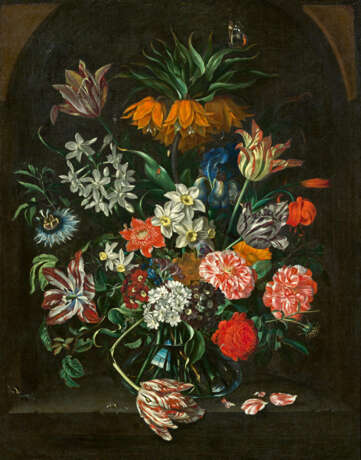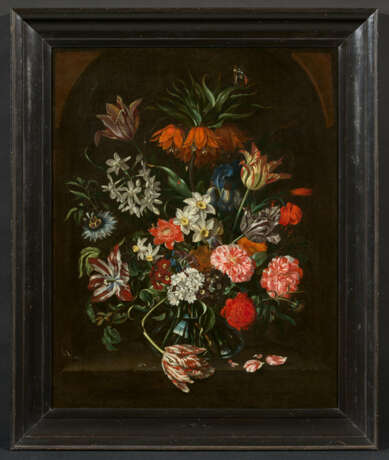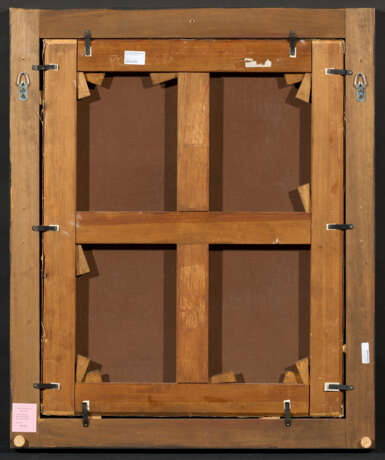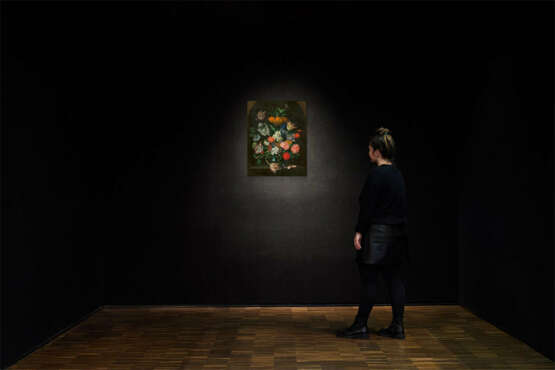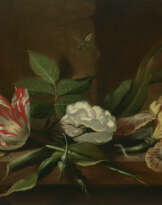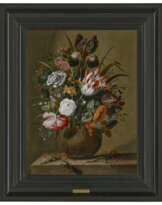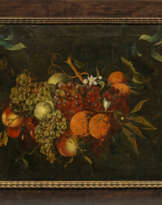Jacob Marrel. Magnificent Floral Still Life with Imperial Crown, Tulips, Daffodils and Other Flowers in a Vase
14.11.2024 15:00UTC +01:00
Classic
Sold
19000EUR € 19 000
| Auctioneer | VAN HAM Kunstauktionen GmbH |
|---|---|
| Event location | Germany, Köln |
| Buyer Premium | 32% |
Archive
The auction is completed. No bids can be placed anymore.

ID 1319775
Lot 1206 | Jacob Marrel. Magnificent Floral Still Life with Imperial Crown, Tulips, Daffodils and Other Flowers in a Vase
Estimate value
€ 25 000 – 45 000
1614 Frankenthal - 1681 Frankfurt am Main
Title:
Magnificent Floral Still Life with Imperial Crown, Tulips, Daffodils and Other Flowers in a Vase.
Date:
1668.
Technique:
Oil on canvas.
Mounting:
Relined.
Measurement:
73 x 58cm.
Notation:
Signed and dated left side of the stone slab: "J. Marrel fecit. 1.6.6 8".
Frame:
Framed.
Provenance:
Private Collection France before 1999;
Gallery Sanct Lucas, Vienna;
Gallery Lahcen & Rabe, Saarbruecken;
Neuse Gallery, Bremen;
Röchling Collection, Baden-Baden.
A magnificent bouquet of flowers stands in a transparent glass vase in a closed, semi-circular niche with a protruding stone slab. Against the dark background, the colours of the flowers shine like orange, red and white fireworks with a few contrasts of blue, brown and green. The bouquet is loosely arranged, with short-stemmed and very long-stemmed specimens arranged together to create the dynamic splendour of the flowers.
One of the elegant, mottled tulips has been ruined by its long, thin stem: it is broken, but there is still a minimal connection at the break. However, the flower head, which lies exactly on the edge of the stone balustrade, is in danger of falling down soon. Perhaps the stem is not broken because of the weight of the flower but is the victim of one of the many insects that can only be discovered at a second glance in the splendour of the blossom. Various beetles, ants, spiders and caterpillars enliven the 'nature morte', and on the far left, at the edge of the niche, a snail crawls. For all their beauty and artful arrangement, picked flowers always symbolise transience, as emphasised by the first fallen rose petals and the broken stem of the tulip.
Jacob Marrel, who painted this magnificent still life dated 1669, is the only known pupil of Georg Flegel (catalogue 1205). After his father's death, the 13-year-old boy was apprenticed to the pioneer of still life painting in Germany in Frankfurt in 1627. In 1634, Jacob Marrel can be traced to Utrecht, where he worked - presumably as a journeyman - in the workshop of Jan Davidsz. De Heems was the leading painter of floral still life in the Netherlands. Ambrosius Bosschaert the Younger, who lived in Utrecht and specialised in flower paintings, influenced Marrel's work. After the death of his first wife, Jacob Marrel returned to Frankfurt, where he was granted citizenship in 1651 and married the widow of Matthäus Merian the Elder. Their daughter, born in 1647, was educated by her stepfather, the future naturalist and artist Maria Sibylla Merian. In 1664, Jacob Marrel moved back to Utrecht for an extended period and, in addition to his stepdaughter, also took his pupil, the young Frankfurt artist Abraham Mignon, with him, whom he in turn placed as a journeyman with his old master Jan Davidsz. De Heem mediates. Jacob Marrel returned to Frankfurt am Main for good in 1679, where he died in 1681. It is known that the painter Jacob Marrel was also active as an art dealer in Frankfurt and Utrecht and he also traded in flower bulbs. His paintings are characterised by an almost scientific observation and precise depiction of flora and fauna. The present work is evidence of this from his second phase of life, now as a master in Utrecht.
| Artist: | Jacob Marrel (1613 - 1681) |
|---|---|
| Applied technique: | Oil |
| Auction house category: | Old Master Paintings |
| Artist: | Jacob Marrel (1613 - 1681) |
|---|---|
| Applied technique: | Oil |
| Auction house category: | Old Master Paintings |
| Address of auction |
VAN HAM Kunstauktionen GmbH Hitzelerstr. 2 50968 Köln Germany | ||||||||||||||
|---|---|---|---|---|---|---|---|---|---|---|---|---|---|---|---|
| Preview | |||||||||||||||
| Phone | +49 221 92586215 | ||||||||||||||
| Fax | +49 221 92 58 62 4 | ||||||||||||||
| Buyer Premium | 32% | ||||||||||||||
| Conditions of purchase | Conditions of purchase | ||||||||||||||
| Business hours | Business hours
|
